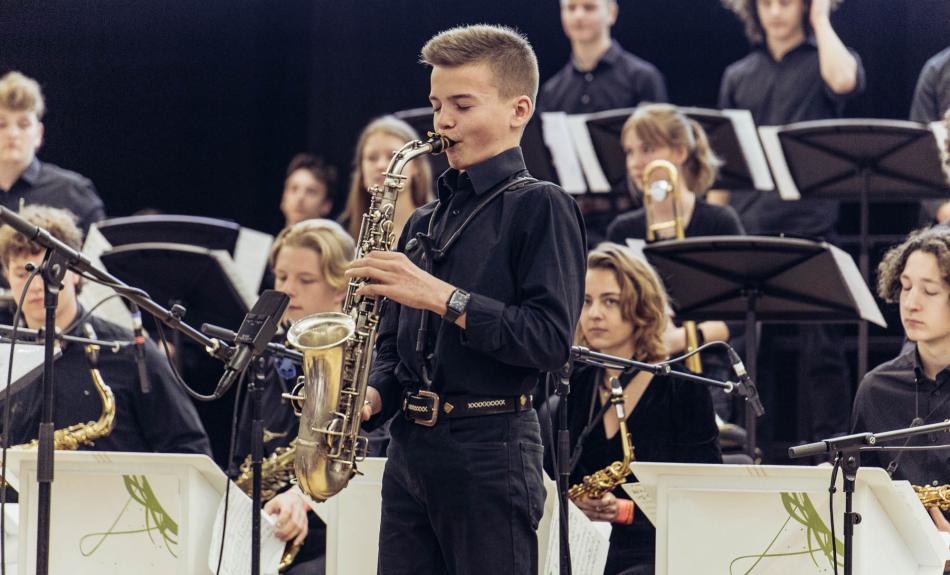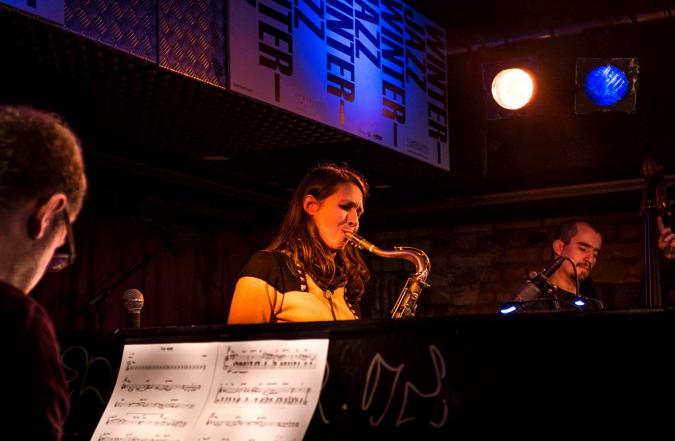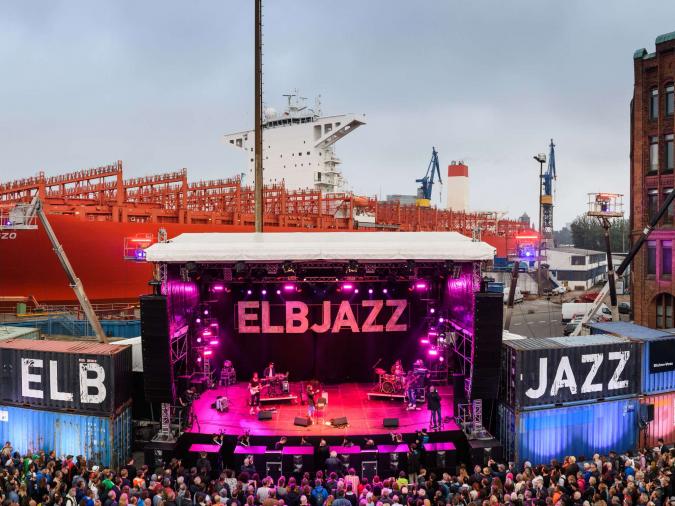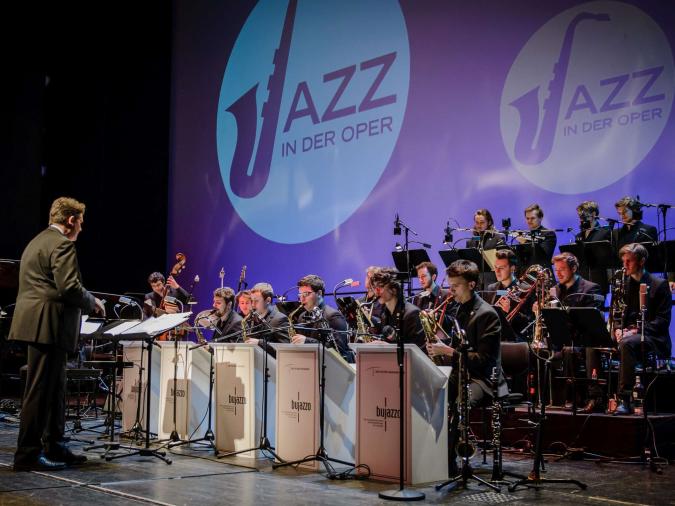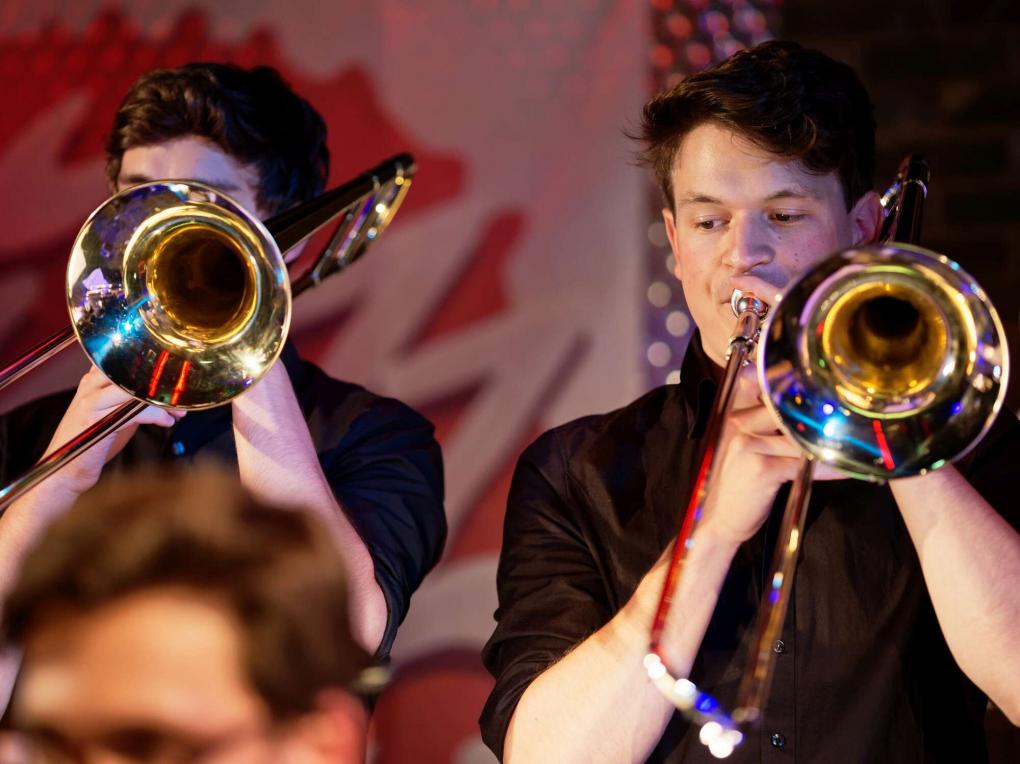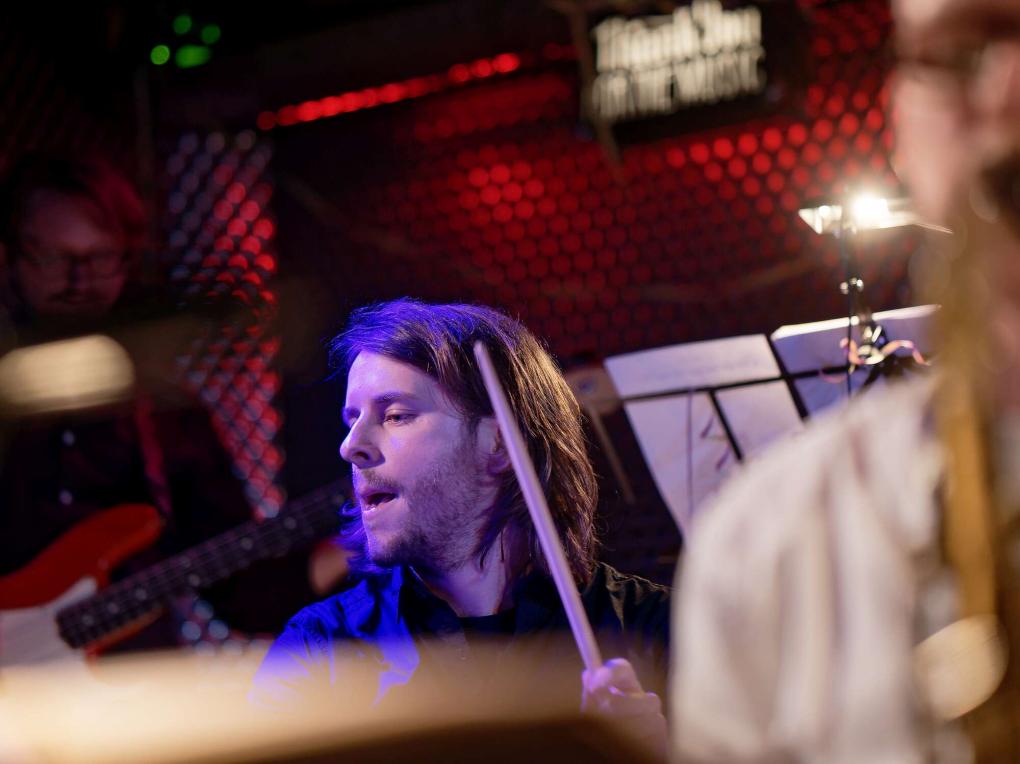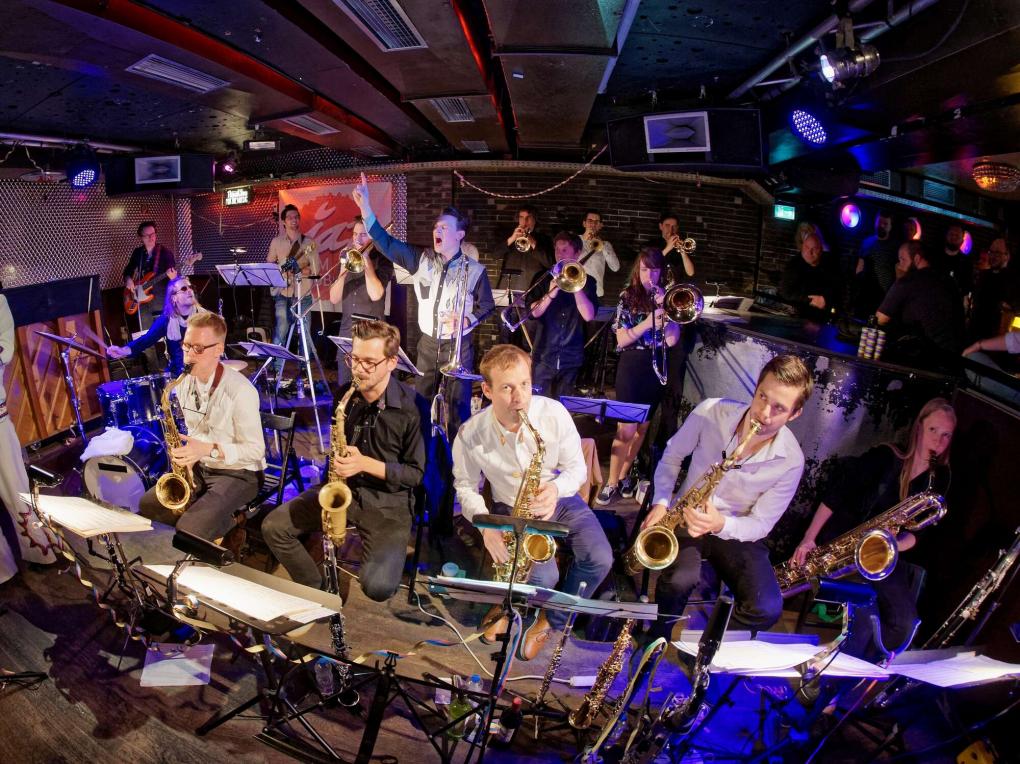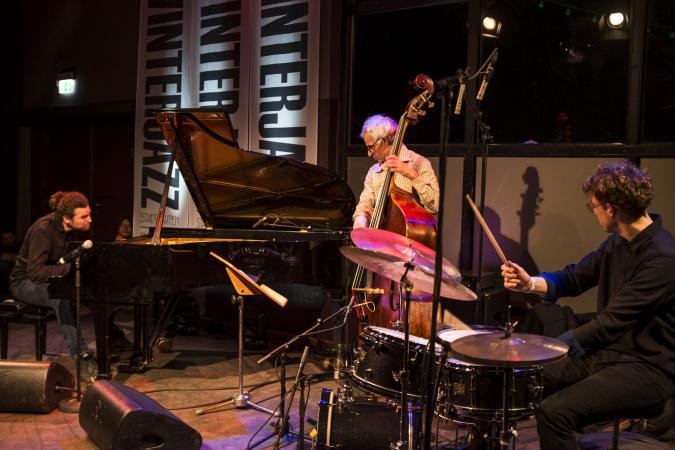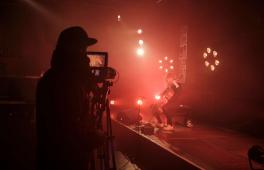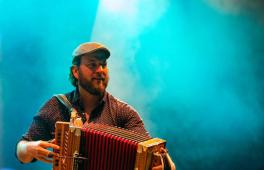Jazz in Germany is noted for its independence, diversity and huge range of styles, from traditional jazz and swing to various hues of mainstream jazz, fusion, cool and free jazz, all the way to today’s many (still) nameless experimental hybrids with world music, ambient music, hip-hop, pop, romanticism and contemporary art music. Jazz-lovers can listen to a multitude of local and international musicians at festivals, in clubs (some supported by the public sector) and concert halls, on radio or from an impressive array of small record labels and a lesser number of larger ones.
Even so-called orchestral jazz, which requires trained composers and arrangers for its existence and fairly large ensembles for its performance, with all the organisational and financial obstacles this entails, has a large and active community of fans. This applies not only to the four professional big bands of Germany’s state broadcasting corporations, but equally to the many large formations founded by individual artists and musicians’ initiatives, such as Niels Klein’s Loom, the Subway Jazz Orchestra (founded by the Cologne musicians’ initiative KLAENG), the improvising big-band The Dorf from the Ruhr region or the ingenious Andromeda Mega Express Orchestra or the stylistically versatile formation Jazzrausch Bigband.
The polyphony of jazz in Germany becomes evident in the study ‘Jazz as a profession’, which was conducted for the first time in 2016 on the initiative of the Jazzinstitut Darmstadt, the IG Jazz Berlin and the UDJ at the Institute for Cultural Policy at the University of Hildesheim, based on a survey of professional jazz musicians. [1] In 2022, the study was expanded and supplemented with the subtitle ‘Living and working conditions of jazz musicians in Germany’. [2]
The Jazz Study 2022 points out: ‘The profession of jazz musician is not a legally protected job title. There are no valid criteria for the inclusion or exclusion of people in the group of professional jazz musicians.’ [3] The so-called scene is heterogeneous, with players who are connected to the political and professional networks to very different degrees and are artistically active in extremely diverse styles.
Clubs, concerts, festivals
Most jazz is heard in live performance. According to the Jazz Study 2022 there were more than 12,000 insured rock, pop and jazz musicians registered with the Künstlersozialkasse, Germany’s social insurance scheme for artists. 1,500 members are currently organised in the German Jazz Union, the national interest group for German jazz musicians. At the same time, as the Jazz Study 2022 confirms, it is difficult to determine the number of professional jazz musicians active in Germany today. However, student numbers are rising. Compared to just under 500 students enrolled in jazz and popular music at the turn of the millennium, two decades later the Federal Statistical Office recorded around three and a half times as many, which is also due to the now larger range of training programmes in the field of popular music. [4]
In many cases the musicians have gathered in initiatives that perceive and represent their interests on various levels. These initiatives function as contact partners for local and regional cultural authorities, the federal government and concert organisers.
Perhaps the most outstanding and exemplary instance of a lastingly successful, predominantly local musicians’ initiative is the Stadtgarten club in Cologne. One of the most successful and internationally renowned jazz venues in Europe, it was founded in the 1980s by the musicians’ initiative Kölner Jazz Haus. One generation later the jazz collective KLAENG made networking the focus of its activities. In both cases a central part of their work falls on running a record label. A younger generation of musicians has now taken over the organisational baton in Cologne and is cooperating successfully and effectively with the representatives of the city’s and the state of North Rhine-Westphalia’s (NRW) cultural policy.
According to current estimates from the Federal Jazz Conference and the Darmstadt Jazz Institute, there are more than 700 venues in Germany that feature jazz among their offerings. [5] Jazz is primarily big-city music; it is in big cities that most of the venues are located and most of the musicians live, even though the cost of living is generally higher there than in rural areas – a problem given the musicians’ generally low incomes. In contrast, coverage in rural areas and small towns is often meagre.
Many venues in large cities and university towns are under professional management and capable of offering jazz programmes with regional, national and international artists covering a wide range of styles several times a week, or even on a daily basis. Besides the Stadtgarten in Cologne, these include Munich’s Jazzclub Unterfahrt, Berlin’s A-Trane, Quasimodo and B-Flat, Hamburg’s Birdland and the Kampnagel-Fabrik, Dortmund’s domicil the traditional Jazzkeller in Frankfurt am Main and the Bunker Ulmenwall in Bielefeld. In Berlin, an important venue for jazz and contemporary music has developed in the Radialsystem, which works for the independent scene with an interdisciplinary approach. A comprehensive list of venues can be found on the website of the Darmstadt Jazz Institute. [6]
Clubs in small towns – small clubs altogether – present concerts once or twice a week, though not always with jazz music. Several venues also offer mixed cultural programmes that regularly feature jazz, such as the Alte Feuerwache (Mannheim), Karlstorbahnhof (Heidelberg), Muffat Hall (Munich) and Centralstation (Darmstadt). They are operated and largely financed by the cities where they are located. Almost all these venues have one thing in common: they are unable to secure the livelihoods of their operators and performers solely via the mechanisms of the market. Using various channels, they obtain subsidies from municipalities and state governments, from private donors and associations. Nevertheless, all operators of such venues constantly fall prey to self-exploitation. Support from the public sector has the added effect of providing public recognition, thereby serving as a source of motivation.
Prestigious big-city concert halls increasingly offer more and more jazz in their programmes as a matter of course, having limited themselves for years to the occasional gig for popular artists. Hamburg's Elbphilharmonie concert hall is currently presenting itself as particularly ambitious in terms of original curatorial work. Comparable institutions such as the Philharmonies in Cologne and Berlin, the Alte Oper in Frankfurt, the Dortmund Konzerthaus and Munich’s Gasteig (currently in its interim venue Gasteig HP8) receive support from their respective municipalities, and often additionally from private sources, such as donor’s associations.
As the venues cannot finance themselves from box office alone, they partly offset their expenses by renting their space for private events, concerts by outside organisers or gastronomic operations. Since 2013 many clubs have been able to improve their working conditions through APPLAUS, a prize awarded for concert programmes in independent venues. This indirectly benefits the musicians as well. [7]
Besides concerts and series from various organisers and the club infrastructure, jazz audiences also take their bearings on a broad array of festivals. As a rule, the festivals take place annually or sometimes biannually, each at roughly the same time of the year. The spectrum ranges from open-air summer pop or classical events with a jazz division to festivals with a pronounced stylistic bent and lavish large-scale events that attract considerable public attention. The Frankfurt summer concert series ‘Jazz im Palmengarten’ is unique among the festivals. It was founded in 1959 by Werner Wunderlich and is now organised by the Frankfurt Jazz Initiative.
The most important jazz festivals in Germany are traditionally the moers festival, held on the Lower Rhine at Whitsuntide every year since 1972; the German Jazz Festival in Frankfurt am Main, the longest running jazz festival in the world (founded in 1953); and the Berlin Jazzfest, held in late autumn every year since 1964. This latter festival is sponsored by Berliner Festspiele GmbH and the jazz departments of Germany’s First Broadcasting System (ARD) and is directed by rotating curators. The A l'Arme festival is held in Berlin's Radialsystem. The Jazz Baltica festival is organised annually to promote cultural cooperation between the countries bordering the Baltic Sea. In Cologne, the Cologne Jazz Week has established itself, as well as two regular festivals organised by the musicians' initiative KLAENG: the KLAENG Festival and Summer KLAENG. In Nuremberg, the Nuejazz Festival has developed into a widely recognised event. Among German festivals, but also internationally, there is now a cooperative willingness to benefit artists and possibly reduce costs for the festivals without compromising the plurality of festival profiles.
Over the last two decades new types of festival have emerged that have attracted a large amount of attention. The most important is Enjoy Jazz (founded in 1999), which is organised as a joint inter-state venture by cultural institutions in Heidelberg, Mannheim and Ludwigshafen and attracts a large audience of wide-ranging stylistic interests every year. The festival offers a six-week series of concerts from early October to mid-November at various venues in the Rhine-Neckar region, sometimes incorporating such neighbouring genres as pop, rock, hip-hop or electro. Another festival, Winterjazz Köln (founded in 2012), adopts a New York model, focusing on Cologne’s Stadtgarten and using three stages simultaneously. There are also concerts in surrounding pubs and, during the day, at the city’s kiosks. Entrance to all Winterjazz concerts is free of charge. A third festival with a novel conception is ELBJAZZ, held in the Hamburg harbour district since 2010. As with Winterjazz, it is impossible for listeners to hear all the concerts. The venues are found in the dockland surroundings of HafenCity, several being reachable by waterway. All three festivals have one thing in common: they incorporate new venues, and thereby relate to the urban environments in which they are embedded. Compared to the traditional jazz audience, their listeners are younger and less tied down to particular styles.
‘Jazz views itself as a fundamentally international music’
The beginnings of jazz in Germany
The history of jazz in the Federal Republic of Germany began relatively late compared to other European countries. In the 1930s and 1940s jazz was ostracised, suppressed and in some cases subject to criminal prosecution. Only after the Second World War did jazz return to the country in altered form as highbrow concert music with a message of freedom. Avant-garde cool jazz took root in Frankfurt am Main, producing what is sometimes called the Frankfurt Sound, the first independent stylistic development in German jazz. When Frankfurt failed to become the capital of the newly founded Federal Republic of Germany (contrary to widespread expectations), the interested public awarded it the substitute title of ‘jazz capital.’ The musicians of the Frankfurt scene thus came to represent the new era. The brothers Emil and Albert Mangelsdorff and other Frankfurt jazzmen, the trumpeter, theorist and writer Carlo Bohländer, the concert organisers Horst Lippmann and Fritz Rau, the bustling journalist and organiser Heinz Werner Wunderlich: all became much-admired pioneers of Germany’s new jazz scene.
German jazz has always had a political background, not only in these early years, and not only in Frankfurt, but nationwide. Its image in Germany was expressly anti-nationalist, anti-racist and flamboyantly democratic. The jazz scene has naturally felt obligated to uphold this image, and has done so, with few exceptions, to the present day. This principle is also consistent with a culture-political milestone in the early history of West Germany: the Poland tour of the Frankfurt All Stars in 1957 (largely initiated by Heinz Werner Wunderlich) and its triumphant appearance at the Sopot Jazz Festival. Here jazz became a vehicle for the first cultural encounter between the former enemy nations – a deeply moving and lifelong memory for all who took part in the tour.
Today’s Federal Republic of Germany emerged as a federal state from four post-war zones of occupation, a divided former capital, and more than 40 years of partition into two states belonging to hostile geo-political blocs. During these four decades jazz evolved differently in the two parts of the country. In the West the American influence initially sparked a stylistic evolution expressly orientated on Western Europe, with so-called free jazz becoming its standard-bearer from the mid-1960s on. Developments in East Germany were, in contrast, quieter and less internationally aligned. Here the scene was relatively small, and high-quality composition, as well as exemplary figures such as Hanns Eisler and Kurt Weill, were no less influential than folk music and workers’ songs. Few East German jazz musicians managed to break through to international recognition. Among the internationally visible exponents of East German jazz, beginning in the mid-1970s, was the quartet Synopsis, with Ernst Ludwig Petrowsky (saxophone), Günter Sommer (drums), Ulrich Gumpert (pianist-composer) and Konrad Bauer (trombone), which adopted the name Zentralquartett even before the fall of the Wall. Others were the bands headed by Hannes Zerbe and the formations associated with the guitarists Helmut Sachse and Uwe Kropinski. From then on, the contacts between jazz musicians of the two German states became increasingly frequent, so that the scene could easily merge following the upheavals of 1989–90. Even so, the consequences of their contrasting histories are still discernible. [8]
Training and further education
The first degree programme in jazz at a German institution of higher learning was established as early as 1928 at the Dr Hoch Conservatory in Frankfurt am Main, where it was headed by Matyás Seiber, only to be summarily scrapped in 1933. Almost six decades had to pass before another academic training programme in jazz could be established in Frankfurt, when a post-graduate jazz programme was founded in the 1990s at the University of Music and the Performing Arts under the leadership of Karl Berger. It, too, was disbanded after a few years. At present the Dr Hoch Conservatory (apart from the private Frankfurter Musikwerkstatt, a state-recognised music academy for jazz and popular music) is the only educational facility in Frankfurt with a degree programme in jazz. Other cities had greater success. Cologne University of Music and Dance in particular has done yeoman’s service in its importance to the jazz scene, not only in the city, but throughout the nation. The roots of this long-lasting effect may possibly date from the late 1950s with the appointment of Bernd Alois Zimmermann as professor of composition (1958). Zimmermann, who taught the later free jazz advocate Alexander von Schlippenbach, was quick to integrate jazz combos into his orchestral music, thereby immediately enhancing the acceptance of contemporary jazz as an art form. Since then, jazz has featured in established courses of study at 19 German universities and music academies. The educational standards of jazz musicians in Germany are correspondingly high, and its schools increasingly attract students from abroad who lack such conditions at home.
Most universities and conservatories train students to become instrumentalists, vocalists and educators. The offerings are highly diverse and incorporated into various areas of study, such as instrumental and vocal training, music education and popular music. The largest educational institutes with a jazz and pop programme are Cologne University of Music and Dance and the Berlin Jazz Institute, a facility operated jointly by the University of the Arts and Hanns Eisler School of Music. Institutes of intermediate size can be found in Hamburg, Nuremberg, Essen, Freiburg, Mannheim and Weimar. The Felix Mendelssohn Bartholdy Academy of Music and Theatre in Leipzig has been playing an increasingly important role in contemporary jazz for several years. Smaller jazz departments can be found in Stuttgart, Saarbrucken, at Dr Hoch's Conservatory and the University of Music and Performing Arts in Frankfurt am Main, in Dresden and at the University of Mainz. Mannheim also has the Baden-Württemberg Pop Academy (founded in 2003), whose course offerings also include preparation for the mechanisms of the music market. The German Music Information Centre (miz) provides an overview of training centres and courses of study in the field of jazz.
Because jazz musicians are generally unable to survive on their concert appearances and CD sales, teaching is a major source of income, [9] whether privately or at public music schools, and whether individually, in workshops or in ensemble instruction. As a result, music schools have become significant pillars of support for the jazz scene, firstly by offering initial instruction to young musicians, and secondly by lending important support to active professionals. Music schools also prepare aspiring applicants for jazz programmes at the university level and offer degrees of their own.
On average, jazz musicians are highly educated. The Jazz Study 2022 shows that the proportion of graduated musicians is highest in the younger age groups and gradually declines with increasing age. There are still occasional reservations about academic music training among older jazz musicians, which may be related to their own - more oral/aural - paths to music and their own profession. In the age group of today's 21 to 30-year-olds, 93 per cent have a degree in music, in the age group of 31 to 40-year-olds even 99 per cent. In the 41 to 50 age group, the proportion drops to 85 per cent, in the 51 to 60 age group to 81 per cent and in the over 60 age group to 60 per cent. It should also be noted that the consistently extremely high standard of education contrasts with the average precarious pay for the work. [10]
Promoting young talent
In jazz, too, the cultivation of young talent cannot be entirely separated from the principle of competition. The most important tool in this respect, in addition to courses of instruction, is the nationwide competition ‘Jugend jazzt’ (Youth Plays Jazz), a cross between festival, showcase, contact and information clearing house, workshop and seminar partly patterned after Germany’s youth competition for classical music, ‘Jugend musiziert.’ Originally it was devised for formations no larger than a tentet, but since 2010 it has also been held for big bands. In an initial phase the competition is carried out at regional and state levels and judged by panels of experts. In the second phase the winners of a first prize at state level go through to the nationwide ‘Jugend jazzt’ Forum, held in a different city each year. Unlike other music competitions, prizes are awarded not just to those who finish first, second and third, but (if possible) to all participants. The prizes include studio recordings, participation in festivals, workshops and gift certificates for the music trade. ‘Jugend jazzt’ is supported in many ways, the main sponsor being the German Music Council.
Another well-organised tool for talented young jazz musicians are the State Youth Jazz Orchestras (LJJO), conceived at the state level as educational institutions, and the Bonn-based German National Youth Jazz Orchestra (BuJazzO), established in 1987. One co-founder of the BuJazzO was the legendary trombonist and band leader Peter Herbolzheimer, who also served as its first director. Once again, its main sponsor is the German Music Council.
The oldest LJJO, jokingly referred to by musicians as the ‘country kids,’ is the ensemble founded in North Rhine-Westphalia in 1975. Each LJJO is sponsored by its respective state music council, with public funding now institutionalised with in the state ministries concerned. The LJJOs collaborate closely and effectively with the statewide ‘Jugend jazzt’ competitions. To become a member of an LJJO the young musician must generally pass an audition open to any interested applicant, though talents discovered in the statewide competitions are also invited to join. As a rule, LJJO members meet in four working phases every year and hold on average from ten to 20 concerts annually. The repertoire, drawn from the classical big band tradition, invariably inspires young talents to try their hand at arranging and composition. Many German jazz musicians famous today at home and abroad can look back on an LJJO or BuJazzO phase in their career. The pool of musicians from which these institutions draw their talents gather in an astonishing number of formations under the general heading of big band: club bands, school bands, private amateur bands. According to unofficial estimates, there are more than 4,000 such bands in Germany today.
Augmenting the systematic promotion of young talent by the music councils is a long list of prizes, scholarships and competitions underwritten by various sponsors. Many cities, such as Ingolstadt, Frankfurt, Cologne, Leipzig and Stuttgart, award prizes and grants to jazz musicians, and in some cases have been doing so for years. Germany’s state broadcasting corporations are also involved: the Jazz Prize of South-western Broadcasting Corporation (SWR) is one of the most long-lived and prestigious jazz prizes in the country. Central German Broadcasting Corporation (MDR) and Western Broadcasting Corporation (WDR) also hand out widely recognised awards in several categories. The Albert Mangelsdorff Prize of the German Jazz Union (Deutsche Jazzunion, or DJU), formerly the Union of German Jazz Musicians (Union Deutscher Jazzmusiker, or UDJ), is awarded every two years at the Berlin Jazzfest. In the meantime, the cultural ministries of most German states likewise have annual prizes or grants awarded by panels of experts, not to mention regional prizes awarded by foundations, initiatives, and associations.
In North Rhine-Westphalia, a new funding programme for outstanding musicians from the jazz genre has been established on the initiative of the European Centre for Contemporary Music at the Stadtgarten, funded by the Ministry of Culture and Science and the City of Cologne. It operates under the name Nica Artist Development and offers artists based in NRW support in form of masterclasses, residencies, and concerts. [11] In contrast to other funding measures, this funding programme is designed for the long term, i.e. for three years. New artists are accepted each year and encouraged to network and professionalise in every respect. The name of this funding programme, Nica, is reminiscent of the legendary patron of avant-garde jazz Pannonica de Koenigswarter.
Since 2021, the German Jazz Prize has been awarded annually in cooperation between the Initiative Musik and the Federal Government Commissioner for Culture and the Media. The award is to be established as a cultural flagship event. The German Jazz Prize is awarded by a jury, in contrast to the ECHO, which was awarded by the Deutsche Phono-Akademie, the cultural institute of the German Music Industry Association (BVMI). The award came under political scrutiny and has been discontinued as it was linked to economic data.
The German Music Information Centre [12] provides a comprehensive overview of prizes and funding, highlighting current funding opportunities. According to the Jazz Study 2022, 65 per cent of jazz musicians have received general funding in the past five years.
Jazz as a profession: ensembles and big bands
All that remains of the formerly impressive number of dance bands and entertainment orchestras of Germany’s broadcasters are the four radio big bands (NDR, WDR, SWR and hr), whose members are able to work under permanent contracts. These ensembles occupy an important place in the musical programmes of their respective broadcasting corporations, headed by principal conductors and supplied with high-quality material by a varying series of arrangers. The big band of Northern German Broadcasting Corporation (NDR) had a trailblazing function in the artistic reorientation of the NDR’s former studio band, with a key role being played since 1980 by the NDR-editor Wolfgang Kunert and the pianist, composer, and bandleader Dieter Glawischnig. Soon the big bands of Hessian Broadcasting Corporation (hr) and Western Broadcasting Corporation (WDR) were taking the Hamburg model as their guide. All in all, these professional ensembles have raised Germany’s big band music to new artistic heights and attracted a discerning audience.
A special place among radio formations is occupied by the storied hr jazz ensemble, which proceeded from the Frankfurt All Stars in 1957. Rather than consisting of permanently employed members, it recruits its players from the Rhine-Main region and invites guest musicians for special projects. The participants meet on a regular basis for rehearsals and recording sessions and function almost exclusively as a studio band.
Indepedent scene
The results of the Jazz Study 2022 convey an ambiguous picture: on the one hand, the participants seemed in principle very satisfied with their profession. Their level of education is high, three-quarters having earned a university degree. They stem from educated surroundings and are regionally, nationally, and even internationally networked.
On the other hand, the economic position of jazz musicians can at best be called precarious. According to the Jazz Study 2022, 65 per cent of full-time professionals earn less than €20,000 annually with their music, and very often much less. Only 14 per cent earn more than €40,000. For women, the average income situation in jazz is even worse than for men. A full 84 per cent fail to reach the minimum fee of €250 per person and gig proposed and advocated by the UDJ. The musicians must generally produce and finance their CDs themselves, which in most cases become an additional expense rather than a source of income. Streaming does not play a significant role in the income situation of jazz musicians. Rarely are they paid for rehearsal time, and sometimes not even for travel and lodging expenses. Musicians capable of earning their living by composing and performing music for theatre, film, or television number among the lucky ones of their trade. Germany’s social insurance scheme for artists (Künstlersozialkasse), which insures around 80 per cent of full-time working musicians, is of existential importance for securing the musicians’ basic welfare, and in many cases, it will be unable to preserve them from poverty in old age.
Concert activities have deteriorated drastically for all musicians in the wake of the coronavirus pandemic, with not only the number of concerts but also attendance figures falling significantly from one day to the next. After all, 80 per cent of those surveyed in the Jazz Study 2022 received coronavirus aid. Financial support was also provided by the NEUSTART KULTUR rescue package put together by the Federal Government Commissioner for Culture and the Media. In addition, digital concert formats have been able to alleviate the hardship here and there. Currently (mid-2023), the concert and audience situation appear to be improving in small steps.
Most jazz musicians are thus forced to take on organisational, teaching, cultural or administrative work, and occasionally outside jobs. In this light, both jazz studies suggest removing jazz subsidies from the realm of traditional cultural subsidies and viewing it as a cross-sectional task at both state and federal levels, which should involve the various ministries (social, educational, scientific, and cultural) and municipal authorities.
International exchange
Germany subsidises the exportation of German jazz (as happens e.g. in the Scandinavian countries or via Bureau Export in France) only to a limited extent. The Initiative Musik offers funding for foreign tours, including telephone counselling, on application. The Goethe-Institut, which is affiliated to the Federal Foreign Office, has increasingly functioned as a disseminator of German jazz abroad since the mid-1960s, when it supported and funded the Albert Mangelsdorff Quintet’s tour of Southeast Asia, giving rise to the LP Now Jazz Ramwong. Today many German musicians and bands can look back to international tours and performances that would not have been possible without the Goethe Institute.
Jazz views itself as a fundamentally international music; its inquisitive players are intent on wide-ranging and stimulating exchanges and are generally well networked across national borders. Nevertheless, German jazz musicians are not necessarily equally as present abroad as their foreign counterparts are here. A showcase festival such as the German Jazz Meeting in Bremen (held during the annual Jazzahead! trade fair) is a systematic attempt to alter this situation, but has not yet been imitated.
Until well into the 1990s Germany was virtually a paradise for American jazz musicians, who languished on small fees and side jobs at home but were viewed as stars in Germany – and paid accordingly. This is no longer the case. For several years the German concert industry has increasingly placed its focus on European musicians. Bands from Scandinavia, Switzerland and France are relatively well-known and active in Germany. Several German musicians gathered experience and reputations abroad before returning to Germany. In turn, musicians from other European countries or the United States have settled in Germany and joined its national scene. Today creative artists and audiences alike seldom think in terms of nationality, and restrictions on international exchange tend to be material rather than mental in nature.
Radio
The broadcasting systems of the Federal Republic of Germany have served from the very beginning as major vehicles for the dissemination of jazz. For several years the main impetus came from Southwest German Radio in Baden-Baden (SWR), where Joachim Ernst Behrendt, later ironically termed the ‘jazz pope,’ worked as a journalist, producer, and tireless initiator. His Jazzbuch, first published in 1953, underwent seven heavily revised and enlarged new editions in the decades that followed (since 2005 under the aegis of SWR’s jazz journalist Günther Huesmann). It served as the standard reference book for generations of jazz listeners and played an important role in jazz’s public image. [13] It was also Baden-Baden that gave rise in the 1960s to the New Jazz Meeting, which remains in existence today, and introduced modern jazz to the Donaueschingen Festival, still one of the world’s most prestigious festivals of contemporary music. The traditional Darmstadt Summer Course, which is both a festival and a platform for discourse, provides a gradually expanding space to improvised music.
In 1957 Hessian Radio (hr) in Frankfurt founded its own jazz ensemble, which still exists today. It is also the current sponsor of the German Jazz Festival, established by the German Jazz Federation in 1953 and now the oldest continuous jazz festival in the world. West German Radio (WDR) also mounts its own annual jazz festival, originally in various cities within its broadcast area and since 2017 in Gütersloh City Theatre.
The broadcasters’ dance and entertainment orchestras, once major bastions of utilitarian jazz, continued to present special broadcasts on television at prime broadcast times. After they were disbanded in the 1980s, only four broadcasters have maintained big bands with permanently employed members: hr (Frankfurt), WDR (Cologne), NDR (Hamburg) and SWR (Stuttgart). Their image resides increasingly in high-quality artistic productions with innovative arrangers and bandleaders and a large number of concerts within their broadcasting area (sse above).
Jazz and improvised music have been present on Germany’s public broadcasters since the earliest days of the Federal Republic. The broadcasts are devoted to historical and current styles and concepts of improvisation, offer portraits of musicians, and provide information on regional initiatives, concerts, and festivals. The broadcasters also cooperate with festivals and concert organisers and lend them financial support by recording and broadcasting their concerts. Not only does this allow the recordings to be exploited in the media, it also serves to document regional events and enhance them in the public eye. Besides practicing active journalism, the jazz departments also function as producers and communicators, thereby forming an important pillar of the jazz scene. With their technological infrastructure, the broadcasters give musicians an opportunity to make studio recordings under professional conditions. Nevertheless, there have been internal disputes within the public broadcasters for years in which the representation of contemporary jazz plays a paradigmatic role. Jazz editors increasingly see themselves on the defensive in terms of media policy and consider their work and their significance for the broadcasting landscape to be increasingly called into question by the so-called ‘format radio.’
In contrast, after promising beginnings in the 1990s, jazz is rarely featured on commercial radio, and then almost exclusively in niches. The last exception is Jazz Radio in Berlin, which broadcasts various jazz subgenres on an ongoing basis. Other private radio programmes limit their jazz offerings to fixed broadcast times, usually at late hours, and often in league with clubs and concert organisers. [14] For some time now, musicians have been increasingly using digital formats (such as links to YouTube videos) for self-promotion, so that their applications to concert organisers, journalists, juries or the Goethe-Institut do not necessarily have to be accompanied by CDs, which are a significant cost factor, but which, musicians fear, often go unheard by the addressees.
Research and documentation
Jazz scholarship is relatively new in Germany. As might be expected, it is found in all 19 German Musikhochschulen where jazz is taught. The international exchange between German scholars and their counterparts in Switzerland, Austria, Italy, the UK and the United States is lively and productive.
One pioneer of jazz scholarship was Ekkehard Jost (1938–2017), a publicist, musicologist, bandleader, and musician who taught in Gießen. His book Free Jazz of 1975 was the first analytical study of this style. [15] His list of publications includes studies of social history, the history of musical eras and stylistic analyses.
In 1983 the city of Darmstadt acquired the posthumous estate of Joachim Ernst Behrendt. This provided the basis for the Darmstadt Jazz Institute, which has given rise since then to a multitude of busy, wide-ranging, and consequential activities. Three full-time and a number of voluntary employees have turned the institute into a combination of archive, concert organiser, research facility and platform for cultural policy. Every two years it mounts ‘Jazzforum,’ a symposium whose discussions are documented in the now impressive series of book publications Darmstädter Beiträge zur Jazzforschung. [16] Since the late 1980s the institute has is sued Wegweiser Jazz, originally intended as a printed guide and address book for active musicians. In the course of several editions the guide grew to become a bulky handbook on jazz in Germany. The last printed edition, published in 2009, consisted of more than 400 pages. Since then, the Wegweiser has been available only in digital form on the institute’s website. [17]
Besides the Darmstadt Institute, there is also the Lippmann + Rau Music Archive in Eisenach, sponsored by the foundation of the same name. Likewise, a combination of archive and research centre, it works closely with the FRANZ LISZT University of Music in Weimar, where detailed jazz research has been conducted for several years. [18]
In 2006 the Radio Jazz Research Association was founded, primarily at the initiative of Bernd Hoffmann, former head of WDR’s jazz department. [19] Here international representatives from journalism, scholarship and performance gather on a regular basis for meetings on particular topics. The meetings are intended to promote the exchange of opinions, information, and knowledge among its members and to further the study and presentation of jazz. They always take place in close co-operation with jazz festivals or with relevantly active university institutes.
Labels publishers and the publishing trade
Despite fundamental changes in the market for sound recordings, Germany has a comparatively large number of jazz labels that release music, sometimes via streaming portals. In the meantime, it has become far more difficult in neighbouring European countries to sell sound recordings via traditional marketing and retail outlets. The recordings are produced by small and usually independent firms of modest size and generally insubstantial profits. Several labels issue their releases in parallel on vinyl LPs, CDs and as internet downloads.
The so-called major labels have largely withdrawn from the market or limit their jazz output to runs no larger than those of independent labels. In contrast, two companies, the labels ECM and ACT (both based in Munich), work today much as the majors used to, namely, in long-term and comparatively systematic cooperations with individual artists, who are given the time they need to stand out and evolve. ECM was founded by Manfred Eicher in 1969, ACT by Siegfried Loch in 1992. Both are constantly concerned with expanding the stylistic range and quality of their repertoire and their artists in a responsible manner.
In addition to these two labels, both of which occupy towering positions in the jazz segment, other labels have specialised in this particular type of music. One is Enja Records (Munich). Others include the jazz and world music label Intuition (owned by Schott Verlag in Mainz), Between The Lines in Cologne (since 1999), JazzHausMusik from the Jazz Haus initiative (Cologne), Skip Records (Hamburg), the jazz, world music and chanson label Traumton (Berlin), which also runs a studio and publishing firm, and Neuklang (Ludwigsburg), which belongs to the fabled Bauer Studios.
Moreover, a large number of active labels have been founded by musicians to produce and distribute the music of individual artists. Among them are Herzog Records, nWog Records, Berthold Records, NRW Records, Rodenstein Records, Jazz ’n’Arts Records, Ozella Records, Pirouet Records, GLM, Jazzwerkstatt, Tangible Music and Jazzsick Records. The website of the Darmstadt Jazz Institute https://www.jazzinstitut.de/en/ provides a comprehensive list of record labels specialising in jazz. Some of these labels rely on the musicians themselves to shoulder the bulk of the costs for their recordings and to sell their own CDs after concerts. A reliable nationwide infrastructure of record shops no longer exists.
Of the internet portals that service jazz, perhaps the most thoroughgoing and reputable is Frank Schindelbeck’s jazzpages.de. In addition to on-going journalistic reports and columns, it contains many links, much information and is steadily being updated. The Goethe Institute likewise maintains a large and annually revised jazz section on its website.
Three nationwide magazines appear regularly in print to inform the interested public. The oldest, Jazz Podium, was founded by Dieter Zimmerle in 1952 and publishes ten issues a year in Stuttgart. Adam Olschewski is now the publisher and editor-in-chief, and the publishing location has been moved from Stuttgart to Bernried on Lake Starnberg. Jazzthetik, founded in Münster in 1987, has six issues per year, and Jazzthing, founded in 1993, publishes five issues annually in Cologne. JazzZeitung, published by ConBrio in Regensburg, was discontinued as a printed edition in 2014 and now has the status of a web portal. [20]
Lobbying and networking
For a long time, culture in the Federal Republic of Germany was a matter left to the municipalities and states. As a result, the culture-political interests of the jazz scene were at first represented exclusively on these two levels and as private initiatives, which is also where lobbying took place. The oldest organisation in German jazz is the German Jazz Federation (DJF), founded in 1952 as a union of jazz concert organisers, at that time primarily Germany’s Hot Clubs. The German Jazz Festival in Frankfurt, now mounted by Hessian Broadcasting Corporation and the city, was likewise originally a DJF event. After languishing for years on the sidelines, the Federation has been revitalised since the early 21st century. One impulse came from the recent strengthening of the Union of German Jazz Musicians (UDJ, meanwhile German Jazz Union – Deutsche Jazzunion DJU), making the DJF stand out as the representative of concert organisers. The two organisations are embroiled in heated debates about mandatory minimum fees.
The UDJ was founded in 1973 as a sort of musicians’ union. For several years its members regularly gathered for a union meeting with jazz festival in Marburg. Since the 1980s the union’s activities have dwindled, and lobbying for musicians has tended to take place on the state level via the state working groups on jazz (Landesarbeitsgemeinschaften, LAGs). Beginning in 2007 the association was revitalised by a younger generation of musicians represented by the pianist Julia Hülsmann, the UDJ’s first chairperson during this phase. In May 2019 the UDJ was renamed to become the German Jazz Union (Deutsche Jazzunion, or DJU).The association was renamed in 2019 and is now called German Jazz Union (DJU). It actively and prudently participates in all debates concerning a better social anchoring and perception of jazz in Germany, sends experts to juries that award sponsorship prizes and scholarships, including the Venue Prize for Rock, Pop and Jazz, the German Jazz Journalism Prize, the Jazzahead! Showcase Jury and the SWR Jazz Prize, as well as the special prize of the DJU at the annual nationwide gathering of ‘Jugend jazzt.’ Every two years the DJU also awards the Albert Mangelsdorff Prize. The association was just as significantly involved in the Jazz Study 2022 as it was in the study conducted in 2016.
The Federal Jazz Conference (Bundeskonferenz Jazz, BKJ) is an informal circle of representatives from the jazz scene. It was founded in 2002 for several reasons, one being that culture was meant to receive a place in the federal government, implying that jazz needed a contact partner for political matters. The BKJ has served this purpose ever since, being consulted about and issuing positions on jazz-related topics in cultural policy. It was here that the idea arose of subsidising venues, which was taken up by Initiative Musik as a grant programme for the rather amorphous-looking market segment for rock, pop, and jazz.
The country’s central subsidisation facility for the music industry is Initiative Musik, a non-profit organisation sponsored by the German Music Council and Germany’s Collecting Society for Performance Rights (Gesellschaft zur Verwertung von Leistungsschutzrechten, GVL). Though the GVL and GEMA are involved in its funding, the bulk of its budget consists of means supplied by the Federal Government Commissioner for Culture and the Media.
The statewide association IG Jazz Berlin views itself as an interest group representing Berlin’s jazz musicians and is active wherever their living and working conditions can be improved. IG Jazz Berlin works on subsidisation schemes (grants for projects, studios, tours, artists, ensembles, and venues), dispatches experts to juries and commissions, speaks out on issues related to cultural policy, took part in the 2016 and 2022 jazz studies, operates a rehearsal room, and raises its voice in cultural policy debates with its own positions, e.g. on the still virulent project to found and operate a House of Jazz in the capital.
As far as the musicians’ area of responsibility is concerned, the current situation of German jazz is good. There is no style, tradition or current development that lacks participants, exponents, and fans in Germany. There is much room for improvement, of course: the audience could be younger and larger, the venues more numerous and affluent, the funding more convenient and generous, the universities better equipped and easier to reach. But compared not only to worse times in the past, but also to most of Germany’s European neighbours, not to mention conditions on the other side of the Atlantic, Germany’s jazz scene has nothing to be ashamed of even after the difficult times of the pandemic in the early 2020s.
Footnotes
- See Thomas Renz, Jazzstudie. Lebens- und Arbeitsbedingungen von Jazzmusiker/-innen in Deutschland (Hildesheim, 2016), online at https://miz.org/de/dokumente/jazzstudie-2016
- See Urs Johnen et.al., Jazzstudie 2022. Lebens- und Arbeitsbedingungen von Jazzmusiker/-innen in Deutschland (Berlin, 2022), p. 25, online at https://miz.org/de/dokumente/jazzstudie-2022
- Johnen, Jazzstudie 2022 (see note 1), p. 16.
- See data at https://miz.org/en/statistics/students-in-degree-programmes-for-music-professions
- See the ‘Spielstätten’ section of the report on the state of jazz in Germany in the pages of the Bundeskonferenz Jazz online at http://www.bk-jazz.de/jazz-in-deutschland/ (accessed on 25 August 2023).
- See https://www.jazzinstitut.de/en/ (accessed on 25 August 2023).
- See https://applaus-award.de/ueber-den-preis/ (accessed on 25 August 2023).
- For further information on the history of jazz in Germany see Wolfgang Knauer “Play yourself, man!”: Die Geschichte des Jazz in Deutschland, (Ditzingen, 2021).
- The Jazz Study 2022 cites a constant 1 per cent income from vinyl and CDs in recent years (since 2019); see also the study ‘Professional Music Making in Germany’ commissioned by the miz, https://miz.org/en/statistics/professional-music-making-in-germany, according to which only 30 per cent of professional musicians in Germany can live exclusively from music.
- According to the Jazz Study 2022, the average gross annual income of German jazz musicians is between 56 and 62 per cent of the national average. According to the data from the Jazz Study 2022, female jazz musicians also earn 25 per cent less on average than their male colleagues. See Jazzstudie 2022, pp. 69-74.
- See https://nica-artistdevelopment.de/en (accessed on 25 August 2023).
- See https://miz.org/en/themes/jazz
- Joachim Ernst Behrendt and Günther Huesmann, Das Jazzbuch – Von New Orleans bis ins 21. Jahrhundert; mit ausführlicher Diskographie (rev. and enl. 7th edn., Frankfurt am Main, 2014).
- Jazz Time Nürnberg, for example, a working department of the Nuremberg Jazz Studio, broadcasts on Thursdays from 10 to 11 pm. Constantin Sieg, who also runs a book-café with jazz programme in Bad Hersfeld, has broadcast regularly on Radio Unerhört Marburg since 1997. Jazz is also broadcast in comparatively smaller amounts on private web radios and streaming services.
- Ekkehard Jost, Free Jazz: Stilkritische Untersuchungen zum Jazz der 60er Jahre (Mainz, 1975); Eng. trans. (New York, 1994).
- Darmstädter Beiträge zur Jazzforschung (Hofheim, 1990-), published at two-year intervals.
- See http://www.jazzinstitut.de/wegweiser-jazz-3/?lang=de (accessed on 25 August 2023).
- See https://jazzomat.hfm-weimar.de/ (accessed on 25 August 2023).
- See https://radiojazzresearch.de/en/ (accessed 25 August 2023).
- See https://www.jazzzeitung.de/cms/ (accessed 25 August 2023).
